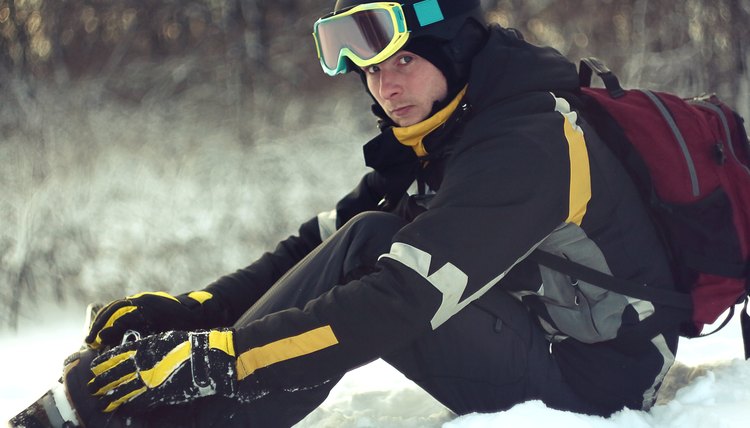Snowboarding Tips for Sore Muscles

Snowboarding, an exciting, fast-paced extreme snow sport, demands a lot from your body. You must simultaneously know how to balance and propel yourself while keeping your body in position to prevent injury. Sore muscles can be a common complaint among snowboarders, particularly beginners who are not accustomed to the rigorous training. Tips to loosen your muscles and treat minor strains can keep you feeling good as you carve and swoop down the slopes.
Stretching
Stretching out tight muscles is an ideal way to prevent and recover from soreness associated with snowboarding. Stretch before you ride as part of a warm up, and cool down with more gentle stretching. Easy exercises such as bending at the waist to touch the ground and reaching up toward the sky loosen your back, arms and legs. Toe raises stretch and strength your calves and ankles; holding on to a chair for support, raise up off of your heels and balance on your toes. Hold the position for several seconds before releasing. Exercises that stretch your hip adductors can also prevent muscle pain. Stand with your feet a shoulder's width apart from one another. Bend one knee while straightening the other leg out to the side. Keep the toes of your straight leg pointing forward to feel the stretch in your hip and groin.
Balancing
People who are new to snowboarding or experienced riders who are in the process of learning new tricks may develop muscle pain because they overwork muscles they usually do not use much. This includes holding your body in positions you are not used to, such as a crouching pose to get ready for a jump or grab. Your legs and ankles can become sore from holding the wide stance required. Improving your balance before you hit the snow, as well as including balance exercises in your daily or weekly workout may prevent sore muscles. Start with simple wobble board exercises with your feet at a shoulder's width apart. Stand on the board -- hold on to a chair for support if needed -- and keep your balance for up to three minutes at a time to condition the muscles you'll be using in snowboarding.
Falling
Learning to fall the right way may save snowboarders from experiencing sore muscles after a day on the trails. Falling incorrectly can cause a variety of injuries ranging from sore muscles to wrist fractures and neck strain. The key to falling correctly is to bend your arms and knees, and tuck your head, explain Frank Gille and Rene Marks, authors of "Snowboarding: Make a Perfect Start." By bending your knees for a front fall, your entire body, particularly your forearms takes the fall instead of just your wrists and hands. Similarly, falling backward with your arms at your sides and head tucked to your chest, you can avoid straining your back and neck muscles.
Treatment
A minor case of sore muscles from snowboarding can be treated at home with over-the-counter products. Non steroid anti-inflammatory drugs, such as acetaminophen and ibuprofen, reduce inflammation of the muscles and relieve pain associated with DOMS, or delayed-onset muscle soreness. DOMS is common in athletes who have recently increased their training regimen or perhaps just overdo it on the slopes now and then. Muscle stiffness and minor pain may take place anywhere from one to three days after you have last ridden the snowboard. Ice packs or heat may also be comforting. Muscle pulls or strains that do not improve on their own within a couple of days or cause severe pain may warrant a doctor's visit to determine if professional medical treatment is needed.
References
Writer Bio
Erica Roth has been a writer since 2007. She is a member of the Society of Professional Journalists and was a college reference librarian for eight years. Roth earned a Bachelor of Arts in French literature from Brandeis University and Master of Library Science from Simmons College Graduate School of Library and Information Science. Her articles appear on various websites.
